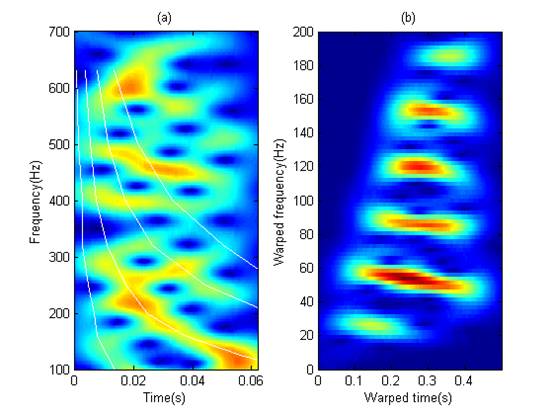
Attenuation of sound in the seabed plays an important role in predicting transmission loss in shallow water waveguides. And methods to invert the attenuation from low-frequency acoustic field data include modal techniques and transmission loss techniques. Since modal separation improves as a sound signal propagates to longer ranges, most of the inversion methods based on modal dispersion were carried out with long range data for which the modal dispersion curves and amplitude ratios can be extracted easily from the received time signal or its spectrum. However, because the shallow water environment is generally range dependent, and so the estimates of attenuation may represent averages over different types of sediment material along the propagation path.
Recently, a time-warping signal processing technique was introduced that enables high resolution of modes at relatively short ranges. Time-warping involves an axis transformation that transforms the original time-frequency relationship of the modes to a new domain in which the modes are approximately tonal and are well resolved. Figure 1 is the comparison between the spectrograms of the original signal and the warped signal. Previous research has shown that warping provides estimates of modal dispersion curves that can be used for inverting sound speed and density in marine sediments. However, the inversion required transforming the resolved modes back into the original time-frequency domain. This research shows that the inversion can be carried out directly in the time-warped domain, and extends to estimate low-frequency seabed attenuation.
The relationship between the warped frequency  , the original frequency
, the original frequency  and the original time t has the form
and the original time t has the form
 , (1)
, (1)
and then the relationship between the group velocity and the warped frequency has the form
 . (2)
. (2)
According to Eq. (2), the dispersion curve can be extracted directly from the warped signal spectrum. The white lines on Figure 1(a) are the extracted curves according to Eq. (2). In the same way, the modal amplitude ratios could also be extracted in the warped domain. Supposing the spectrum of the warped signal is  , the amplitude of the mth mode can be given by
, the amplitude of the mth mode can be given by
 . (3)
. (3)
After getting the modal group velocity curves and modal amplitude ratios, the seabed geoacoustic parameters could be inverted from them. Seabed sound speed and density are inverted from the modal group velocity curves, and the attenuation is inverted from the normalized modal amplitudes. The method is applied to experimental data collected in the Yellow Sea of China during the winter of 2002. The inverted sound speed and density are listed in Table1, which are consistent with the sand-silt-clay sediment at the site, and the attenuation is nonlinear over the frequency band from 125-500 Hz, which are listed in Table 2.

Figure 1(a). Spectrogram of the original signal and the extracted dispersion curves for the first four modes, indicated by the white lines. (b) Spectrogram of the warped signal (100~700 Hz) (Image by ZENG).
| Table 1. The search range and inverted results of the geoacoustic model parameters | |||
| Parameter | Unit | Range step | Inverted result |
| Water depth | m | [28.1 32.1] 0.2 | 29.7 |
| Sound speed | m/s | [1500 1800] 5.0 | 1580.0 |
| Density | g/cm3 | [1.1 2.3] 0.1 | 1.7 |
| Table 2. Estimates of the seabed attenuation | ||||||||
| Frequency (Hz) |
| 125 | 160 | 200 | 250 | 320 | 400 | 500 |
| Attenuation (dB/m) |
| 0.0134 | 0.0334 | 0.0352 | 0.0522 | 0.0567 | 0.109 | 0.174 |
The research has been released in J. Acoust. Soc. Am. (134, EL394 (2013)) and can be searched through the website: http://dx.doi.org/10.1121/1.4822421.
Contact:
ZENG Juan
Institute of Acoustics, Chinese Academy of Sciences, Beijing, 100190, China
Email: Zengjuan_ioa@sina.com

86-10-68597521 (day)
86-10-68597289 (night)

86-10-68511095 (day)
86-10-68512458 (night)

cas_en@cas.cn

52 Sanlihe Rd., Xicheng District,
Beijing, China (100864)

